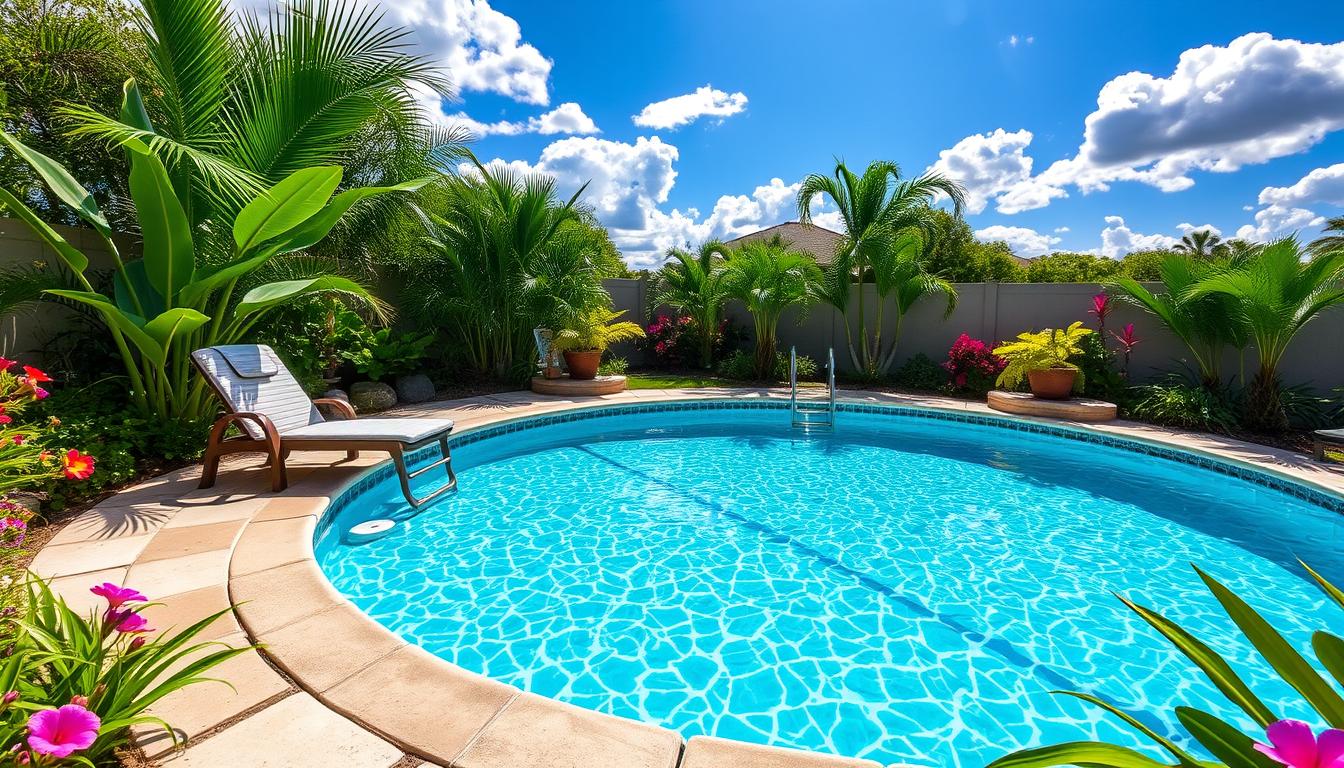
Knowing your 24 ft round pool’s water capacity is vital. It helps with filling, upkeep, and chemical treatments. Let’s explore pool sizing and volume calculation to make estimation easier.
Pool volume affects many aspects of maintenance. It determines chemical amounts for water balance. It also helps estimate fill and drain times.
Knowing your pool’s capacity ensures proper equipment sizing. This includes pumps and filters. With accurate volume data, you can enjoy a well-maintained swimming experience.
Key Takeaways
- A 24 ft round pool with a 54-inch wall height holds approximately 13,594 gallons of water.
- Pool dimensions, including diameter and depth, are essential factors in determining water capacity.
- Calculating pool volume involves using specific formulas based on pool shape and measurements.
- Factors such as evaporation, splashing, and backwashing can affect water levels and require regular monitoring.
- Accurate estimation of pool volume is crucial for proper chemical treatment and maintenance.
Determining the Volume of a 24 Ft Round Pool
Calculating your pool’s volume is crucial for proper maintenance. It helps with chemical balance, filtration, and heating costs. Let’s explore how to determine the volume of a 24 ft round pool.
Understanding Pool Dimensions
A 24 ft round pool refers to its diameter. This is the distance across the pool through its center. The pool’s depth is also important, as it varies from shallow to deep end.
Applying the Formula for Calculating Pool Volume
To find the volume of a 24 ft round pool, use this formula:
V = Diameter x Diameter x Average Depth x 5.9
Here’s what each part means:
- V represents the volume of the pool in gallons
- Diameter is the distance across the pool, which is 24 ft in this case
- Average Depth is calculated by adding the shallow end depth and the deep end depth, then dividing by 2
- 5.9 is a constant used for circular pools to convert cubic feet to gallons
Let’s use an example. If your pool has a 3 ft shallow end and 5 ft deep end, the average depth is 4 ft. Now, let’s plug in the values:
V = 24 ft x 24 ft x 4 ft x 5.9 = 13,593 gallons
Factors Affecting Water Capacity
While the formula gives a good estimate, other factors can affect your pool’s actual water capacity. Wall height, depth variations, and pool shape can all influence the volume.
Above ground pools with higher walls hold more water. Significant differences between shallow and deep ends may affect accuracy. Non-round pools require different formulas for volume calculation.
Here’s a table showing volumes for various round pool sizes:
| Pool Diameter | Wall Height | Volume (gallons) |
|---|---|---|
| 18 ft | 54 in | 8,565 |
| 24 ft | 52 in | 15,292 |
| 30 ft | 54 in | 23,793 |
Knowing your pool’s dimensions helps you calculate its volume accurately. This information is vital for proper maintenance, chemical treatment, and efficient operation. Next, we’ll discuss water requirements and maintenance tips for a 24 ft round pool.
How Many Gallons is a 24 Ft Round Pool?
Pool owners need to know their water capacity. This helps with chemical balance and water usage planning. It also helps estimate utility bills.
Let’s explore how many gallons a 24 ft round pool holds. We’ll also provide helpful pool ownership resources for your backyard oasis.
Gallons Required for a 24 Ft Round Pool
A 24 ft round pool’s water capacity depends on wall height. A standard 52-inch wall pool holds 13,600 to 15,300 gallons. Knowing your pool’s volume is key for proper maintenance.
Let’s compare a 24 ft round pool to other common sizes:
| Pool Shape and Size | Water Capacity (Gallons) |
|---|---|
| 16’x32′ Rectangular | 19,200 |
| 16’x36′ Rectangular | 21,600 |
| 20’x40′ Rectangular | 30,000 |
| 11’x30′ Oval | 7,800 – 8,400 |
| 15’x30′ Oval | 10,600 – 11,500 |
| 17’x33′ Grecian | 19,700 – 22,200 |
| 20’x44′ Grecian | 30,300 |
Estimating Water Needs for Initial Fill and Maintenance
Knowing your pool’s water needs helps with initial filling costs and time. You’ll also need to account for water loss during the season.
Water loss occurs due to evaporation, splashing, and filter backwashing. Plan for these factors to maintain proper water levels.
Expect to lose 1 to 2 inches of water weekly from evaporation. You’ll need to add 2 to 4 inches of water weekly.
Consider these pool ownership resources to manage your water needs:
- Regularly test your pool water chemistry and adjust as needed to maintain proper balance
- Invest in a quality pool cover to minimize evaporation and reduce the amount of debris entering your pool
- Install a water level indicator to easily monitor your pool’s water level and know when to add more water
- Schedule regular maintenance tasks, such as skimming, brushing, and vacuuming, to keep your pool clean and well-maintained
Understanding your pool’s water capacity is crucial. Use these tips for effective maintenance. Enjoy a smooth swimming season with your family.
Conclusion
A 24 ft round pool is a hit among homeowners. It’s roomy and easy to set up. This pool holds about 14,300 gallons of water, perfect for fun family time.
Our research shows aluminum and thick materials are best for pool walls. They last longer and fight rust better. The top 10 above ground pools are known for their strong walls.
Round pools have better water flow than oval ones. This means cleaner water and less work for you.
For a 24 ft round pool, a 1 HP pump works well. Bigger pools might need a 1.5 HP pump. Experts say to turn over the water once or twice daily.
Your filter choice affects flow rate and upkeep. Pick a top-notch above ground pool for years of family fun and memories.







